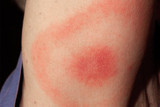Lyme Disease

Lyme disease is a disease mainly associated with skin lesions, damage to the nervous and cardiovascular systems and the musculoskeletal system, prone to long-term course.
The disease can occur at any age, but most often - in children under 15 years of age and adults aged 25-44 years.
Pathogens or cause of the disease: Borrelia.
The sources of Lyme disease are many species of wild and domestic vertebrates and birds (mainly various species of wild rodents, white-tailed deer, moose, etc.). In natural environment, pathogens circulate between blacklegged ticks and wild animals. More than 200 species of wild animals act as feed mites.
The mechanism of transmission of Lyme disease is through the blood, rarely - with the use of raw milk
(primarily goat milk), through the tick bites with its saliva, feces (when rubbed at the bite point).
Immunity after Lyme disease is unstable and a few years after recovery, re-infection is possible.
Risk factors for infection: staying in a mixed forest (habitat of mites), especially from May to September.

Manifestations of Lyme Disease
The incubation period for Lyme disease varies from 1 to 50 days, averaging 10-12 days.
Stage I (local infection)
Develops in 40-50% of those infected during the first month after a tick bite.
Characterized by a flu-like course with fever, headaches, weakness, malaise, pain in muscles and joints, sometimes with severe chills. Body temperature can be high, up to 39-40°C, fever can last for up to 10-12 days. Sometimes nausea and vomiting are noted.
Dry cough, runny nose, sore throat - rarely observed. The main symptom specific to Lyme disease is migratory ring-shaped redness. In approximately 20% of patients, it may be the only manifestation of the first stage of the disease.
First, a spot appears at the site of the tick bite - a patch of uniform reddening, gradually (over several days) expanding in all directions to tens of centimeters in diameter. The edges of the spots become clear, bright, red, raised above the level of healthy skin. In some patients, the center of the spot gradually turns pale, turns into a ring-shaped, acquires a bluish tint. In the area of the spot may be itchy, moderate pain.
When treating with antibiotics, the redness persists for several days, without treatment - up to 2 months or more. After its disappearance, weak pigmentation and peeling are possible.

Stage II
It develops in 10-15% of those infected after several weeks or months (usually in the absence of adequate treatment). It is expressed in the lesion of the nervous and cardiovascular systems (pain in the heart, palpitations), skin lesions in the form of ring-shaped elements, and urticaria.
Other changes: liver damage, eyes, sore throat, bronchitis, kidney damage.
Stage III
It is formed in 1-3 months after the end of the first two phases (sometimes in 6-12 months or more). The disease acquires a long relapsing course with weakness, increased fatigue, headache, increased excitability or depression, sleep disorders, damage to various organs and systems.
Diagnostics
- Blood test
- The reaction of indirect immunofluorescence to detect antibodies to borrelia (the main serological method in Russia)
- Solid phase ELISA for antibodies to borrelia (the results can be negative at stage I of the disease or against the background of antibacterial therapy and, on the contrary, are false positive for fever of rocky mountains, systemic lupus erythematosus, rheumatoid arthritis)
- PCR for detection of Borrelia protein in tissues, serum and synovial fluid (most specific).
Lyme Disease Treatment
Lyme disease is treated at a hospital in an infectious disease unit.
At Stage I
Antibacterial therapy for 2-3 weeks, either one of the antibiotics:
- Doxycycline 100 mg two times a day.
- Amoxicillin 500 mg three times a day (children 25-100 mg per 1 kg of body weight per day).
- reserve antibiotic - Ceftriaxone 2 gramms intermuscular injection once per day.
Against the background of antibacterial therapy, the Jarish-Herksheimer reaction may develop (fever). In this case, antibiotics are canceled for a short time and then they are resumed at a lower dose.
At Stage II:
Antibiotic therapy for 3-4 weeks:
- In the absence of changes in the cerebrospinal fluid, Doxycycline 100 mg two times a day or Amoxicillin 500 mg three times a day.
- If there are changes in the cerebrospinal fluid - Ceftriaxone 2 gramms intermuscular injection once per day, Cefotaxime 2 gramms intermuscular or intravenous injection every 8 hours.
At Stage III:
- Doxycycline 100 mg two times a day or Amoxicillin 500 mg three times a day for 4 weeks.
- In the absence of effect - Ceftriaxone 2 gramms intermuscular injection once per day, Cefotaxime 2 gramms intermuscular or intravenous injection every 8 hours for 2-3 weeks.
Prognosis for illness
Early initiation of antibiotic therapy can reduce the duration of the course and prevent the development of the late stages of the disease.
At a late stage, the treatment of Lyme disease is not always successful - if the nervous system is affected, the prognosis is poor.
Doxycycline during pregnancy should not be used.
